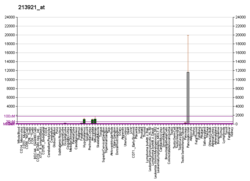Somatostatin
Somatostatin, còn được gọi là hormone ức chế hormone tăng trưởng (GHIH) hoặc theo một số tên khác, là một hormone peptide điều chỉnh hệ thống nội tiết và ảnh hưởng đến sự dẫn truyền thần kinh và tăng sinh tế bào thông qua tương tác với các thụ thể somatostatin kết hợp với protein G nội tiết tố thứ cấp. Somatostatin ức chế bài tiết insulin và glucagon.[2]
Somatostatin có hai dạng hoạt động được tạo ra bởi sự phân cắt thay thế của một preproprotein duy nhất: một dạng bao gồm 14 amino acid (hiển thị trong hộp thông tin bên phải), loại còn lại bao gồm 28 amino acid.[3][4]
Trong số các động vật có xương sống, có sáu gen somatostatin khác nhau được đặt tên là SS1, SS2, SS3, SS4, SS5 và SS6.[5] Zebrafish có tất cả sáu.[5] Sáu gen khác nhau, cùng với năm thụ thể somatostatin khác nhau, cho phép somatostatin sở hữu một loạt các chức năng.[6] Con người chỉ có một gen somatostatin, SST.[7][8][9]
Danh pháp
[sửa | sửa mã nguồn]Từ đồng nghĩa của "somatostatin" bao gồm:
- hormone tăng trưởng ức chế hormone (GHIH)
- giải phóng hormone tăng trưởng hormone ức chế (GHRIH)
- somatotropin giải phóng yếu tố ức chế (SRIF)
- somatotropin giải phóng hormone ức chế (SRIH)
Sản phẩm thay thế tổng hợp
[sửa | sửa mã nguồn]Octreotide (tên thương hiệu Sandostatin, Novartis Dược phẩm) là một octapeptide bắt chước somatostatin tự nhiên về mặt dược lý, mặc dù là chất ức chế mạnh hơn hormone tăng trưởng, glucagon và insulin so với hormone tự nhiên và có thời gian bán hủy dài hơn nhiều (khoảng 90 phút, so với 2 phút 3 cho somatostatin). Vì nó được hấp thu kém từ ruột, nên nó được tiêm tĩnh mạch (tiêm dưới da, tiêm bắp hoặc tiêm tĩnh mạch). Nó được chỉ định cho điều trị triệu chứng của hội chứng carcinoid và bệnh to đầu chi. Nó cũng được tìm thấy tăng sử dụng trong các bệnh đa nang của gan và thận.
Lanreotide (Somatuline, Ipsen Dược phẩm) là một loại thuốc được sử dụng trong quản lý bệnh to cực và các triệu chứng gây ra bởi các khối u thần kinh, đặc biệt là hội chứng carcinoid. Nó là một chất tương tự tác dụng dài của somatostatin, như octreotide. Nó có sẵn ở một số quốc gia, bao gồm Vương quốc Anh, Úc và Canada, và đã được Cục Quản lý Thực phẩm và Dược phẩm Hoa Kỳ chấp thuận để bán tại Hoa Kỳ vào ngày 30 tháng 8 năm 2007.
Xem thêm
[sửa | sửa mã nguồn]- Trục dưới đồi - tuyến yên
Tham khảo
[sửa | sửa mã nguồn]- ^ “Human PubMed Reference:”.
- ^ "somatostatin". Encyclopædia Britannica. Encyclopædia Britannica Online. Encyclopædia Britannica Inc., 2016. Web. 04 mag. 2016 <http://www.britannica.com/science/somatostatin>.
- ^ “Sect. 5, Ch. 4: Structure, Synthesis, and Secretion of Somatostatin”. Endocrinology: The Endocrine Pancreas. Medical College of Georgia. tr. 16. Bản gốc lưu trữ ngày 5 tháng 4 năm 2008. Truy cập ngày 19 tháng 2 năm 2008.
- ^ “somatostatin preproprotein [Homo sapiens]”. NCBI Reference Sequence. National Center for Biotechnology Information Support Center (NCBI).
- ^ a b Liu Y, Lu D, Zhang Y, Li S, Liu X, Lin H (tháng 9 năm 2010). “The evolution of somatostatin in vertebrates”. Gene. 463 (1–2): 21–8. doi:10.1016/j.gene.2010.04.016. PMID 20472043.
- ^ Gahete MD, Cordoba-Chacón J, Duran-Prado M, Malagón MM, Martinez-Fuentes AJ, Gracia-Navarro F, Luque RM, Castaño JP (tháng 7 năm 2010). “Somatostatin and its receptors from fish to mammals”. Annals of the New York Academy of Sciences. 1200: 43–52. doi:10.1111/j.1749-6632.2010.05511.x. PMID 20633132.
- ^ “Entrez Gene: Somatostatin”.
- ^ Shen LP, Pictet RL, Rutter WJ (tháng 8 năm 1982). “Human somatostatin I: sequence of the cDNA”. Proceedings of the National Academy of Sciences of the United States of America. 79 (15): 4575–9. doi:10.1073/pnas.79.15.4575. PMC 346717. PMID 6126875.
- ^ Shen LP, Rutter WJ (tháng 4 năm 1984). “Sequence of the human somatostatin I gene”. Science. 224 (4645): 168–71. doi:10.1126/science.6142531. PMID 6142531.
Đọc thêm
[sửa | sửa mã nguồn]- Florio T, Schettini G (tháng 9 năm 2001). “[Somatostatin and its receptors. Role in the control of cell proliferation]”. Minerva Endocrinologica. 26 (3): 91–102. PMID 11753230.
- Yamada Y, Reisine T, Law SF, Ihara Y, Kubota A, Kagimoto S, Seino M, Seino Y, Bell GI, Seino S (tháng 12 năm 1992). “Somatostatin receptors, an expanding gene family: cloning and functional characterization of human SSTR3, a protein coupled to adenylyl cyclase”. Molecular Endocrinology. 6 (12): 2136–42. doi:10.1210/me.6.12.2136. PMID 1337145.
- Yamada Y, Post SR, Wang K, Tager HS, Bell GI, Seino S (tháng 1 năm 1992). “Cloning and functional characterization of a family of human and mouse somatostatin receptors expressed in brain, gastrointestinal tract, and kidney”. Proceedings of the National Academy of Sciences of the United States of America. 89 (1): 251–5. doi:10.1073/pnas.89.1.251. PMC 48214. PMID 1346068.
- Brazeau P, Vale W, Burgus R, Ling N, Butcher M, Rivier J, Guillemin R (tháng 1 năm 1973). “Hypothalamic polypeptide that inhibits the secretion of immunoreactive pituitary growth hormone”. Science. 179 (4068): 77–9. doi:10.1126/science.179.4068.77. PMID 4682131.
- Shen LP, Pictet RL, Rutter WJ (tháng 8 năm 1982). “Human somatostatin I: sequence of the cDNA”. Proceedings of the National Academy of Sciences of the United States of America. 79 (15): 4575–9. doi:10.1073/pnas.79.15.4575. PMC 346717. PMID 6126875.
- Shen LP, Rutter WJ (tháng 4 năm 1984). “Sequence of the human somatostatin I gene”. Science. 224 (4645): 168–71. doi:10.1126/science.6142531. PMID 6142531.
- Montminy MR, Goodman RH, Horovitch SJ, Habener JF (tháng 6 năm 1984). “Primary structure of the gene encoding rat preprosomatostatin”. Proceedings of the National Academy of Sciences of the United States of America. 81 (11): 3337–40. doi:10.1073/pnas.81.11.3337. PMC 345502. PMID 6145156.
- Zabel BU, Naylor SL, Sakaguchi AY, Bell GI, Shows TB (tháng 11 năm 1983). “High-resolution chromosomal localization of human genes for amylase, proopiomelanocortin, somatostatin, and a DNA fragment (D3S1) by in situ hybridization”. Proceedings of the National Academy of Sciences of the United States of America. 80 (22): 6932–6. doi:10.1073/pnas.80.22.6932. PMC 390100. PMID 6196780.
- Panetta R, Greenwood MT, Warszynska A, Demchyshyn LL, Day R, Niznik HB, Srikant CB, Patel YC (tháng 3 năm 1994). “Molecular cloning, functional characterization, and chromosomal localization of a human somatostatin receptor (somatostatin receptor type 5) with preferential affinity for somatostatin-28”. Molecular Pharmacology. 45 (3): 417–27. PMID 7908405.
- Demchyshyn LL, Srikant CB, Sunahara RK, Kent G, Seeman P, Van Tol HH, Panetta R, Patel YC, Niznik HB (tháng 6 năm 1993). “Cloning and expression of a human somatostatin-14-selective receptor variant (somatostatin receptor 4) located on chromosome 20”. Molecular Pharmacology. 43 (6): 894–901. PMID 8100352.
- Kaupmann K, Bruns C, Hoyer D, Seuwen K, Lübbert H (tháng 9 năm 1993). “Distribution and second messenger coupling of four somatostatin receptor subtypes expressed in brain”. FEBS Letters. 331 (1–2): 53–9. doi:10.1016/0014-5793(93)80296-7. PMID 8405411.
- Aguila MC, Rodriguez AM, Aguila-Mansilla HN, Lee WT (tháng 5 năm 1996). “Somatostatin antisense oligodeoxynucleotide-mediated stimulation of lymphocyte proliferation in culture”. Endocrinology. 137 (5): 1585–90. doi:10.1210/en.137.5.1585. PMID 8612489.
- Sharma K, Patel YC, Srikant CB (tháng 12 năm 1996). “Subtype-selective induction of wild-type p53 and apoptosis, but not cell cycle arrest, by human somatostatin receptor 3”. Molecular Endocrinology. 10 (12): 1688–96. doi:10.1210/me.10.12.1688. PMID 8961277.
- Dournaud P, Boudin H, Schonbrunn A, Tannenbaum GS, Beaudet A (tháng 2 năm 1998). “Interrelationships between somatostatin sst2A receptors and somatostatin-containing axons in rat brain: evidence for regulation of cell surface receptors by endogenous somatostatin”. The Journal of Neuroscience. 18 (3): 1056–71. PMID 9437026.
- Barnea A, Roberts J, Ho RH (tháng 1 năm 1999). “Evidence for a synergistic effect of the HIV-1 envelope protein gp120 and brain-derived neurotrophic factor (BDNF) leading to enhanced expression of somatostatin neurons in aggregate cultures derived from the human fetal cortex”. Brain Research. 815 (2): 349–57. doi:10.1016/S0006-8993(98)01098-1. PMID 9878821.
- Ferone D, van Hagen PM, van Koetsveld PM, Zuijderwijk J, Mooy DM, Lichtenauer-Kaligis EG, Colao A, Bogers AJ, Lombardi G, Lamberts SW, Hofland LJ (tháng 1 năm 1999). “In vitro characterization of somatostatin receptors in the human thymus and effects of somatostatin and octreotide on cultured thymic epithelial cells”. Endocrinology. 140 (1): 373–80. doi:10.1210/en.140.1.373. PMID 9886848.
- Brakch N, Lazar N, Panchal M, Allemandou F, Boileau G, Cohen P, Rholam M (tháng 2 năm 2002). “The somatostatin-28(1-12)-NPAMAP sequence: an essential helical-promoting motif governing prosomatostatin processing at mono- and dibasic sites”. Biochemistry. 41 (5): 1630–9. doi:10.1021/bi011928m. PMID 11814357.
- Oomen SP, van Hennik PB, Antonissen C, Lichtenauer-Kaligis EG, Hofland LJ, Lamberts SW, Löwenberg B, Touw IP (tháng 2 năm 2002). “Somatostatin is a selective chemoattractant for primitive (CD34(+)) hematopoietic progenitor cells”. Experimental Hematology. 30 (2): 116–25. doi:10.1016/S0301-472X(01)00772-X. PMID 11823046.
- Simonetti M, Di BC (tháng 2 năm 2002). “Structural motifs in the maturation process of peptide hormones. The somatostatin precursor. I. A CD conformational study”. Journal of Peptide Science. 8 (2): 66–79. doi:10.1002/psc.370. PMID 11860030.
 GIẢM
26%
GIẢM
26%
 GIẢM
19%
GIẢM
19%
 GIẢM
20%
GIẢM
20%
 GIẢM
21%
GIẢM
21%
 GIẢM
25%
GIẢM
25%
 GIẢM
18%
GIẢM
18%




:no_upscale()/cdn.vox-cdn.com/uploads/chorus_asset/file/24873961/vlcsnap_2023_08_25_14h40m29s345.jpg)